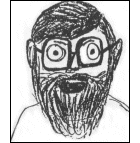

James
Calhoon
Manufacturing
4343 U.S. Highway 87 Havre Mt 59501
(406) 395-4079 www.jamescalhoon.com
Dear Todd And SNC Subscribers: August 1, 2002
On Rifle Bedding
Other than a trigger job, bedding is the most accuracy you can buy for your dollar. Expect to pay $80 to $125 for the job, depending whether or not you opt for pillars. To get the most value and best results, we use pillars.
For bedding compound, we prefer Devcon Aluminum Epoxy. Almost as strong as aluminum, it is impervious to solvents, doesn't rust like steel epoxies, and sticks like sh..t to a blanket.
We do not bed any part of the barrel. Bedding compound is applied at the rear tang (or near the rear screw on Savages) and the front screw and recoil lug area. Remove bedding in front of and under the recoil lug. If recoil lug has no clearance and is not allowed to "walk" with temperature changes, action stresses will result in inaccuracy.
Torque actions screws (1/4") to 40 inch/pounds.That is about all a normal human can twist, using two hands on a good screw driver.
 |
 |
| Barry is only good for 25 in / lbs., | but Fred does an easy 60 foot / lbs. ! |
Most important to a good bedding job is not to apply stress to the actions as the epoxy is curing. Don't use the action screws to "pull down" the action to the stock while curing, although screws can be used for centering. Use a strip of cardboard or rubber band to center the barrel in the fore end. Squeeze the barreled action into the epoxy and maintain pressure with electrical tape or, better yet, 1/4" surgical rubber hose. This method allows the action to mate perfectly to the epoxy when cured. Let it cure for 24 hours. Use car wax as a parting agent. Difficult to remove actions (stuck in the glue) can usually be separated by placing the whole rifle in your deep freeze for an hour, then whack the barrel with a rubber mallet.
That said, let's answer your questions in the order you presented them.
(1) Laminated stocks are stable enough, but they are more "spongy" than a good walnut. If re-torqueing of action screws again and again is to be avoided, pillar bedding is necessary. Pillars are not totally neccessary and can be gotten away with on a good walnut stock. Cooper rifles don't use pillars and shoot excellent groups, but I still prefer pillars myself. Pillars are best made of steel tubing as they are incompressible.
(2) It doesn't matter what material the pillars are made from as long as they don't compress. Substantial thick wall steel tubing is excellent. Aluminum also works well as it is fast to machine and easy to knurl to enable the epoxy to get a good grip.
(3) Aluminum does expand twice as much as steel per degree Fahrenheit temperature change. Steel changes 6 millionths of an inch (.000006") and aluminum 12 millionths of an inch (.000012") per degree F change. But I haven't seen actual proof that the extra expansion makes a noticeable difference when used as bedding materials. Still, I believe steel is the best material for scope mounts as steel offers the least expansion and therefore less sighting variation with tempurature change.
(4) Bedding blocks work nicely when actions are difficult to bed, such as XP100's. As most actions warp from the heat-treating process, bedding is still needed when using a bedding block. I really like H-S Precision and Bell & Carlson stocks with their aluminum inserts. They need no pillars (as they are already inserted), but a thin application of bedding compound is required to accommodate any action warping.
Custom pillar bedding is included on our customized CZ 527's in 19 Caliber. The 19 caliber rifles come in 19 BADGER, 19 Calhoon (Hornet) and 19-223. We also have a complete line of 19 Caliber accessories and components, including bullets (from 28 to 44 grains), Dewey and Bore Tech cleaning rods, Bonanza Dies, and a host of other goodies. Check us out at www.jamescalhoon.com for pictures, informative articles, prices and other informative stuff!